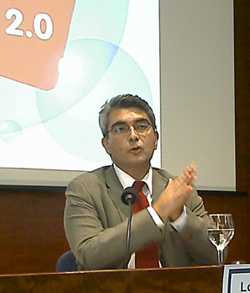Notes from the 4th Internet, Law and Politics Congress.
Session IV
Chairs: Agustí Cerrillo, Law Professor, UOC
Conference
Lorenzo Cotino
Electronic public services: e-government 2.0 The Regulation of E-Government 2.0
Law goes really behind the speed of times. The problem is that Law, or Administrative Law, faces challenging reality: .com can fail, but .gov cannot”
.
At the legal level, the big challenge of the Web 2.0 is the integration of content produced by third parties in another platform — or your content put in a platform run by a third party.

Lorenzo Cotino
Some things that e-Gov 2.0 can bring: G2C
- More information
- Transparency
- Participation
Some things that e-Gov 2.0 can bring: C2G
- Best of feedbacks
- Crest of the wave innovation of early adopters
- Law enforcement by citizens: reports, complaints, etc.
Some things that e-Gov 2.0 can bring: G2G
- Share knowledge, bottom up
Some things that e-Gov 2.0 can bring: C2C
- Participative spaces
Incentives of e-Gov 2.0: motivation, fostering, training. P2P training a successful bet.
The role of Law in e-Gov 2.0 is to bring security to the whole system, and guarantee the citizen’s rights. E.g. not all has to be that transparent, as there are privacy issues concerned.
Some rights:
- Guarantee a contact address
- Compulsory information
- Usability
- Feedback mecanisms
One of the biggest problems we nowadays have in the Internet is anonymity: who’s liable for some published content? And not only anonymity, but the easy flow of content from one place/platform to another one. This is a threat for the development of the e-Administration. Though some anonymity can be good in some aspects of citizenship.

